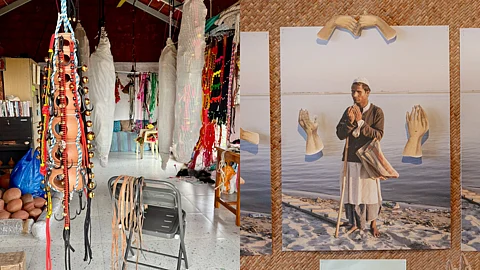
- HOMEGROWN WORLD
- #HGCREATORS
- #HGEXPLORE
- #HGVOICES
- #HGSHOP
- CAREERS
- ABOUT US
- CONTACT US

Across India’s rural landscapes, knowledge often slips through the cracks of state records and sanctioned histories — not because it disappears, but because it refuses to flatten itself into categories that power understands. It lives in gestures; in weathered tools; in rituals that outlast rulers. 'Roots of the Earth', featuring artists Prabhakar Kamble and Akshay Mahajan, listens closely to these fragile transmissions.
The exhibition is an act of gathering the overlooked stories buried beneath caste, colonial record‑keeping, and forced classification. In conversation across media and meaning, the exhibition brings together sculpture, collage, and everyday materials to speak about caste, community, memory, and resistance. Rather than presenting identity as fixed or inherited, the artists show it as something shaped by care, loss, protest, and the persistence of those who refuse to be erased.
Prabhakar's sculptural works begin with humble, locally-sourced materials from his hometown of Kolhapur: terracotta pots, nylon rope, iron hooks, cowbells. These objects carry heavy associations of caste-based labour. For instance, in the 'Chandelier' series and 'Material Turn (2025)', bells and ropes are arranged into moving, rhythmic structures that echo the soundscape of rural Maharashtra. But they also remind us of violence: of people humiliated or harmed for working with animal carcasses or for drawing water from wells marked “not for them”.
His work uses symbols that speak to the realities of caste in India. Ropes evoke both labour and bondage. Pots, traditionally used to carry water, here refer to rituals of death and remembrance. In 'Utarand' (2025), clay pots are stacked into a fragile tower, pierced with holes and threaded with rope. Topped by a powdered indigo elephant, it's a symbol of Ambedkarite resistance that holds spiritual, social, and political weight. The sculpture thus becomes a vessel for many truths like exclusion, and a history of resilience.
Prabhakar's practice is grounded in his experience as a social organiser, and it shows. His work is about reclaiming dignity and memory through materials that are part of daily life. Working with local artisans and learning crafts outside of his caste identity, Kamble challenges both artistic norms and social boundaries. His sculptures aren’t just objects — they’re acts of defiance, healing, and solidarity.
Working beside him yet lodged in different material grammar Akshay's collages and assemblages feel like riverbeds collecting fragments — songs, photos, myths, and folk objects, especially from Assam’s Goalpara district, where borders drawn during colonial rule and the flattening ambitions of ethnography split up communities and erased their languages and customs.His large-scale work People of Clay (2025) gathers together terracotta dolls, bits of textiles, river reeds, and old family photographs. It’s an emotional map of a place shaped as much by rumour and love as by history.
For Akshay, memory isn’t linear. Rather, it accumulates like silt in a river, drifting and layering. His collages bring together elements that might not seem connected at first, but together form a kind of unassuming archive. He tells stories through textures and gestures, whether it's the small hand-pressed doll from Asharikandi or the legend of Behula who sails with her husband’s corpse across a stormy river, refusing to let go. These tales are acts of devotion and survival.
Regionally specific and socially grounded, these works are born of communities. Prabhakar sources his materials in Kolhapur bazaars and works with local artisans; Akshay collaborates with women potters, nomadic storytellers, and theatre groups in Assam. Both are committed to recovery, radical empathy, and a collective memory that's one part rooted in Ambedkarite anti‑caste consciousness, the other in folk psychogeography and oral tradition. Together, their practices challenge modern nation‑building’s impulse to homogenise, omit, and even romanticise without remembering whose labour underpins each handiwork or folk custom.
Water is a recurring figure in both artists' works, not only in its literal invocation via pots or river clay, but as subtext for fluidity, rupture, erasure, and regeneration. Prabhakar's pots that once held water, now hold histories of disappearance and violence; Akshay's silt is river-born, mobile, alive. This exhibition suggests that identity, too, is water-born clay: holding shape only temporarily, yet always carrying the bell‑ring of the past and the sedimented hush of what we choose to remember or forget.
What Roots of the Earth ultimately offers is an act of repair. Across its many forms like terracotta, textile, performance, or pigment, it gathers stories that have long been left outside the frame of 'national culture'. These works do not seek recognition from dominant systems; instead, they insist on a language of their own. Prabhakar and Aksht return to the tactile and the handmade because these are the tools with which resistance has always been built. In its epistemology of rural life, it asks: to whom does tradition belong, who is allowed to craft memory, and how might art remake the stories a nation inherits?
Roots Of The Earth is up for view at Jhaveri Contemporary in Mumbai till August 16.
If you enjoyed reading this here's more from Homegrown:
Witness Satyajit Ray Through Nemai Ghosh’s Lens At An Ongoing Exhibition In Kolkata
The Great Elephant Migration 2025 Intertwines Indian Textile Craft & Conservation
Attend A New Delhi Exhibition Celebrating The Aesthetics & Cultural Legacy Of Gond Art
